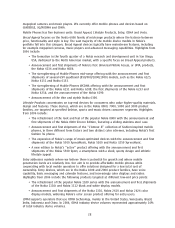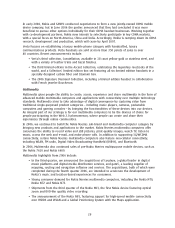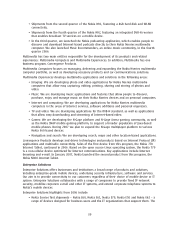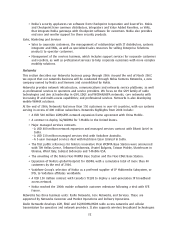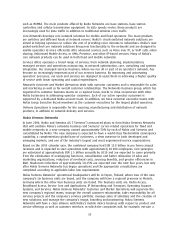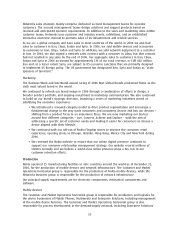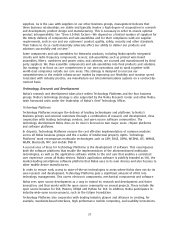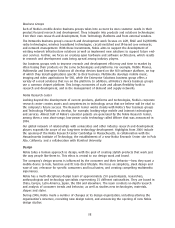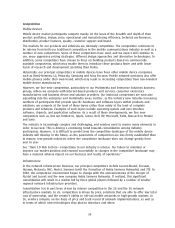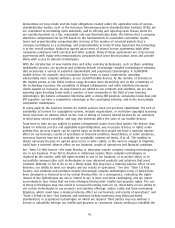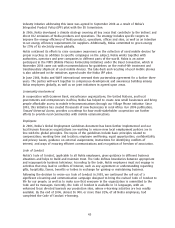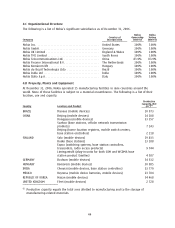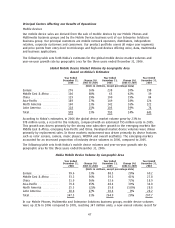Nokia 2006 Annual Report Download - page 39
Download and view the complete annual report
Please find page 39 of the 2006 Nokia annual report below. You can navigate through the pages in the report by either clicking on the pages listed below, or by using the keyword search tool below to find specific information within the annual report.Business Groups
Each of Nokia’s mobile device business groups takes into account its own customer needs in their
productfocused research and development. They integrate into products and solutions technologies
from their own research and development, from Technology Platforms and from external vendors.
The Networks business group’s research and development work focuses on GSM, EDGE and 3G/WCDMA
radio technologies, wireless broadband technologies, circuitswitched and IPbased core networks,
and network management. With these investments, Nokia aims to support the development of
existing network infrastructure solutions as well as implement new solutions to support future end
user services. Further, we focus on creating open hardware and software architecture, which results
in research and development costs being spread among industry players.
Our business groups seek to improve research and development efficiency and time to market by
often basing their products on the same technologies and platforms. For example, Mobile Phones,
Multimedia and Enterprise Solutions all develop devices based on the S60 software platform, on top
of which they install applications specific to their business. Multimedia develops mobile music,
imaging and video applications for S60, while the Enterprise Solutions business group offers a
variety of email solutions that run on the platform. In addition, all Nokia’s device business groups
use a common chipset platform. This brings economies of scale and allows flexibility both in
research and development, and in the management of demand and supply networks.
Nokia Research Center
Looking beyond the development of current products, platforms and technologies, Nokia’s corporate
research center creates assets and competencies in technology areas that we believe will be vital to
the company’s future success. The Research Center works closely with Nokia’s four business groups
and Technology Platforms to develop, for example, leadingedge mobile and Internet technologies
and services. Almost half of Nokia’s essential patents are generated by the Nokia Research Center,
among them a new shortrange, lowpower radio technology called Wibree that was announced in
2006.
Our global network of relationships with universities and other industry research and development
players expands the scope of our longterm technology development. Highlights from 2006 include
the opening of the Nokia Research Center Cambridge in Massachusetts, in collaboration with the
Massachusetts Institute of Technology; the establishment of a new Nokia Research Center site in Palo
Alto, California; and a collaboration with Stanford University.
Design
Nokia takes a human approach to design, with the goal of creating stylish products that work just
the way people like them to. This ethos is central to our design work and brand.
The company’s design process is influenced by the consumer and their behavior—how they want a
mobile device to look, function and fit into their lifestyle. We focus on simplicity, sleek design and
ease of use; relevance for specific consumers and local tastes; and creating compelling multimedia
experiences.
Nokia has a multidisciplinary design team of approximately 250 psychologists, researchers,
anthropologists and technology specialists representing 25 different nationalities. They are based in
China, Europe, Latin America, Japan, the USA and elsewhere. The team conducts indepth research
and analysis of consumer trends and behavior, as well as studies new technologies, materials,
shapes and styles.
During 2006, Nokia made a number of changes at its design organization, including altering the
organization’s structure, recruiting new design talent, and announcing the opening of new Nokia
design studios.
38


